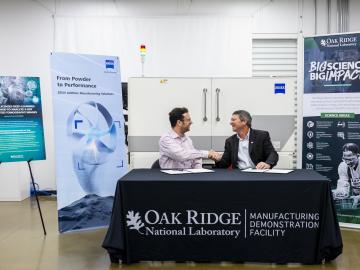
Filter News
Area of Research
- Advanced Manufacturing (3)
- Biology and Environment (18)
- Computational Engineering (1)
- Computer Science (2)
- Energy Frontier Research Centers (1)
- Energy Science (30)
- Fuel Cycle Science and Technology (1)
- Fusion and Fission (11)
- Fusion Energy (1)
- Isotope Development and Production (1)
- Isotopes (3)
- Materials (38)
- Materials for Computing (3)
- National Security (16)
- Neutron Science (16)
- Nuclear Science and Technology (8)
- Quantum information Science (1)
- Sensors and Controls (1)
- Supercomputing (30)
News Type
News Topics
- (-) Advanced Reactors (12)
- (-) Artificial Intelligence (35)
- (-) Biomedical (17)
- (-) Coronavirus (17)
- (-) Cybersecurity (17)
- (-) Grid (16)
- (-) Machine Learning (13)
- (-) Microscopy (17)
- (-) Nanotechnology (29)
- (-) Nuclear Energy (28)
- (-) Partnerships (31)
- (-) Security (12)
- (-) Statistics (1)
- 3-D Printing/Advanced Manufacturing (48)
- Big Data (8)
- Bioenergy (25)
- Biology (26)
- Biotechnology (10)
- Buildings (15)
- Chemical Sciences (35)
- Clean Water (2)
- Composites (12)
- Computer Science (63)
- Critical Materials (11)
- Education (3)
- Element Discovery (1)
- Energy Storage (43)
- Environment (38)
- Exascale Computing (13)
- Fossil Energy (1)
- Frontier (16)
- Fusion (17)
- High-Performance Computing (32)
- Isotopes (20)
- ITER (2)
- Materials (60)
- Materials Science (56)
- Mercury (2)
- Microelectronics (1)
- Molten Salt (3)
- National Security (18)
- Neutron Science (54)
- Physics (26)
- Polymers (13)
- Quantum Computing (13)
- Quantum Science (31)
- Simulation (10)
- Space Exploration (3)
- Summit (22)
- Transportation (26)
Media Contacts

In a finding that helps elucidate how molten salts in advanced nuclear reactors might behave, scientists have shown how electrons interacting with the ions of the molten salt can form three states with different properties. Understanding these states can help predict the impact of radiation on the performance of salt-fueled reactors.

The Department of Energy’s Oak Ridge National Laboratory and Tennessee State University have signed a memorandum of understanding to strengthen research cooperation and provide diverse undergraduate students enriching educational research opportunities at the lab.

ORNL and the University of Texas Rio Grande Valley, known as UTRGV, have signed a memorandum of understanding to strengthen research cooperation and establish a collaborative program for undergraduate research and education, further cementing hi

Susan Hubbard, diputada de Ciencia y Tecnología en ORNL, Can (John) Saygin, vicepresidente mayor de investigación y decano del Colegio de la Escuela de Postgrados en UTGRV, firman un Memorándum de Entendimiento comprometiéndose a fortalecer

ORNL has been selected to lead an Energy Earthshot Research Center, or EERC, focused on developing chemical processes that use sustainable methods instead of burning fossil fuels to radically reduce industrial greenhouse gas emissions to stem climate change and limit the crisis of a rapidly warming planet.

The Department of Energy’s Oak Ridge National Laboratory announced the establishment of the Center for AI Security Research, or CAISER, to address threats already present as governments and industries around the world adopt artificial intelligence and take advantage of the benefits it promises in data processing, operational efficiencies and decision-making.

ORNL has launched a new entrepreneurial start-up program, Safari, as an addition to DOE's Office of Technology Transitions Practices to Accelerate the Commercialization of Technologies program. Safari seeks to connect post-exit entrepreneurs with commercially relevant technologies developed by world-leading scientific experts, which could provide the basis for a new business.

The Department of Energy’s Office of Science has selected three ORNL research teams to receive funding through DOE’s new Biopreparedness Research Virtual Environment initiative.

A new nanoscience study led by a researcher at ORNL takes a big-picture look at how scientists study materials at the smallest scales.

A licensing agreement between the Department of Energy’s Oak Ridge National Laboratory and research partner ZEISS will enable industrial X-ray computed tomography, or CT, to perform rapid evaluations of 3D-printed components using ORNL’s machine


